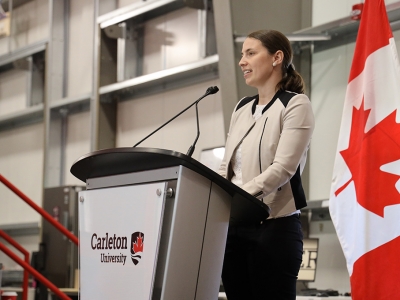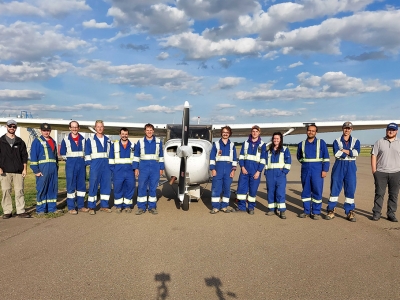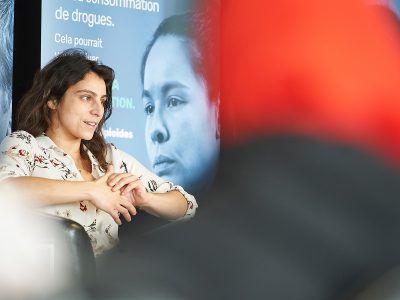By Alex Nahwegahbow
Photos by Chris Roussakis
From February to May this year, a group of Carleton University students under the careful guidance of Daniel “Pinock” Smith, a well-known artist and canoe builder from Kitigan Zibi Anishinabeg, learned how to build a wiigwaas chiimaan—a birchbark canoe.
In collaboration with the university’s Centre for Aboriginal Culture and Education (CACE), the Carleton University Art Gallery (CUAG) hosted weekly gatherings where students, including myself, were introduced to customary Anishinaabe tools, materials and methods in canoe making.
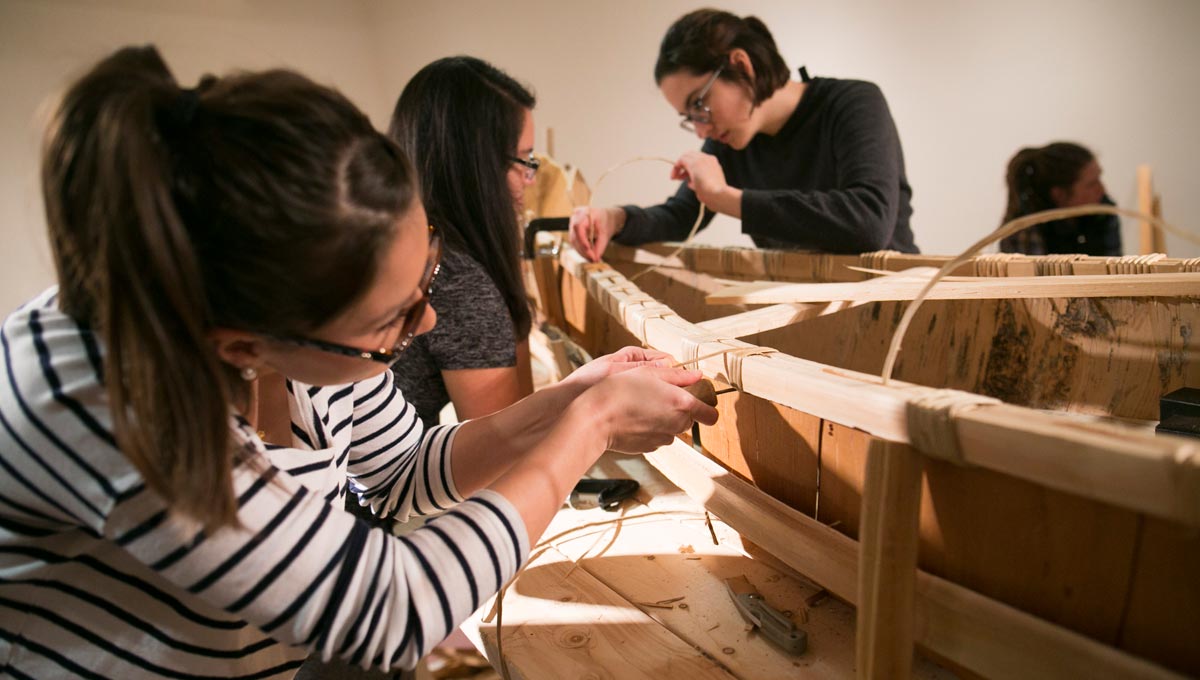
Alexandra Nahwegahbow (left) and other students hard at work.
Beyond what we learned to create with our hands, this work offered us lessons in humility, patience and the value of multiple forms of knowledge. In an interesting turn, as I reflect back on the last few months, it would seem that the most meaningful and important part of this canoe building workshop was that it wasn’t really ever just about the canoe at all.
The crafting of our wiigwaas chiimaan took place during the seasonal shift from winter into spring. The spring—ziigwaan—is customarily a very special time for Anishinaabe. It’s the time of year when the land warms up and the snow melts, giving way to rainfall. Lakes and rivers regain their current, and maple trees in the sugar bush begin to swell with sap.
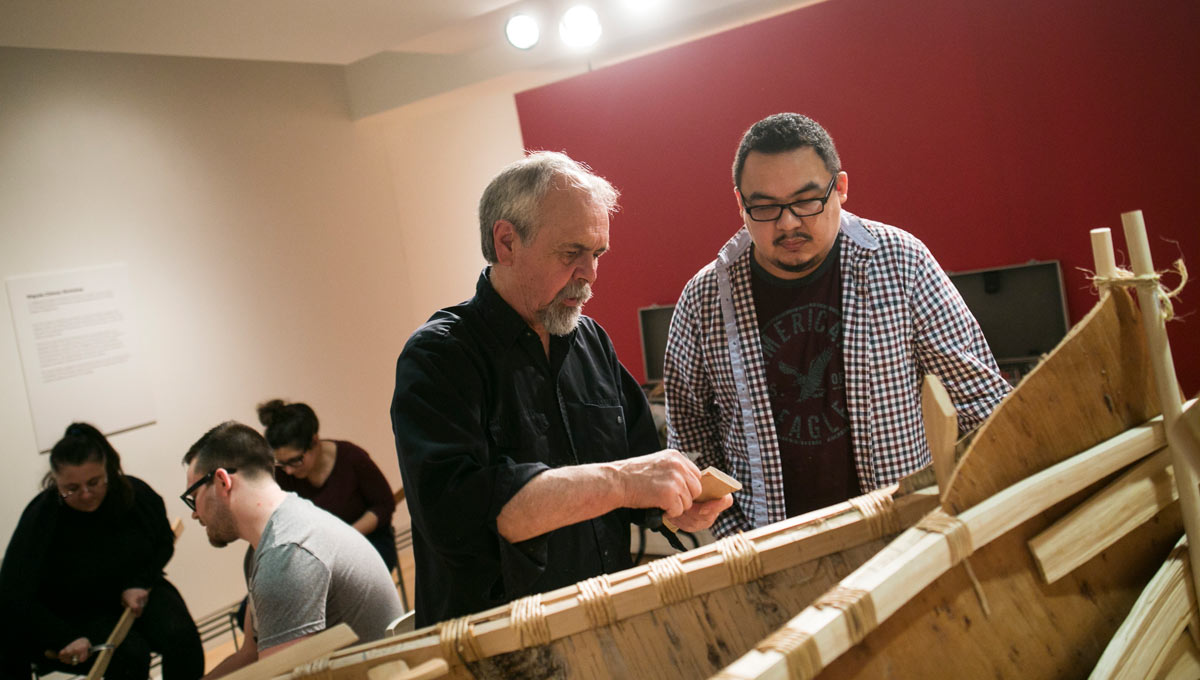
Under the guidance of artist and teacher Daniel “Pinock” Smith, the team crafts.
This is the season when that beloved bark culled from birch trees is highly cherished. For centuries of springtime seasons, the Anishinaabek have skillfully crafted, and sewn with spruce root, beautiful water-tight birchbark containers called bskitenaagan and mokuk to collect, carry and store maple water, syrup and sugar. Embodied in birchbark is this long history of catching and holding sweetness and sustenance which, together with its additional use for transport, was also certainly necessary for survival.
Large sheets of lightweight birchbark cut, stretched and shaped into canoes allowed for easy mobility throughout Anishinaabeaki, a territory permeated by lakes, waterways and complex trade routes.
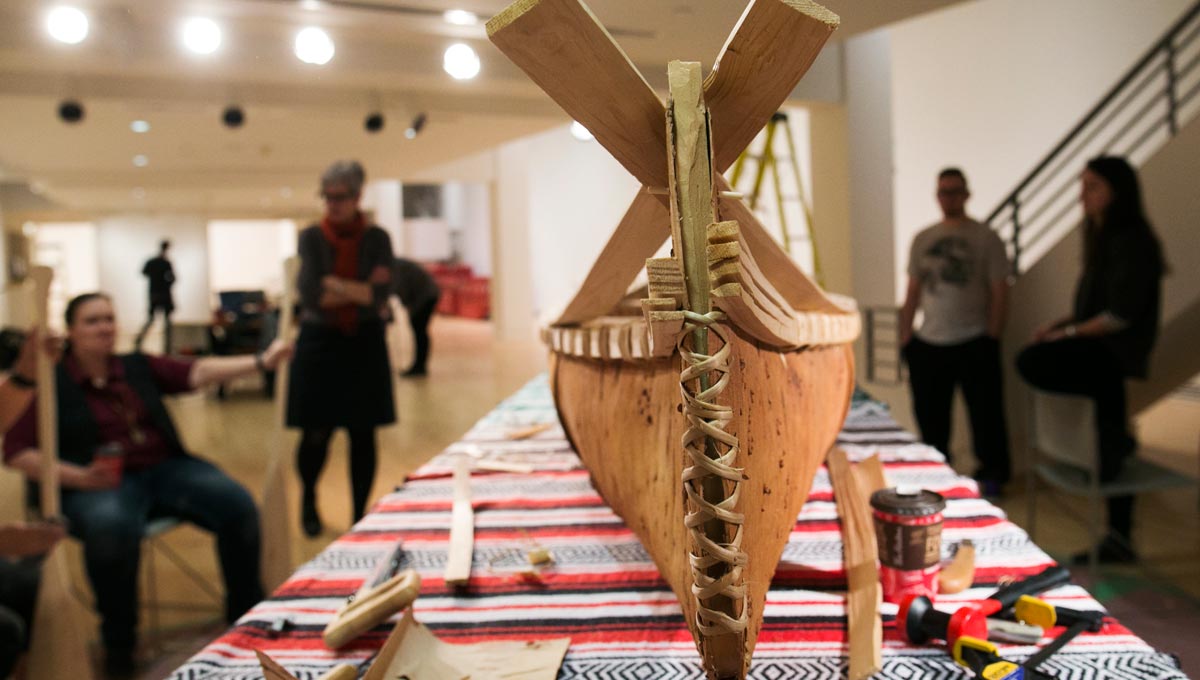
Birchbark Canoe:
An Object that Holds
In one of the first sessions of our canoe building practice, our teacher Pinock described the wiigwaas chiimaan as a vessel – it is a boat to be sure, but in its simplest form he explained, it is also a very large container, much like a bskitenaagan or a mokuk—as I understand it— an object that holds.
As native people, when we see our belongings and the things that we’ve made – whether in a book, in museum storage or in a family member’s living room – we’re never really just looking at them as things.
They are, rather, meaningful objects that have the ability to carry, hold and transmit memory across time and space.
Metaphorically, they are always vessels.
Coming in to some of the last building sessions, as we carefully placed the wooden ribs that shaped the rounded belly of our canoe, I thought about what this object would come to carry.
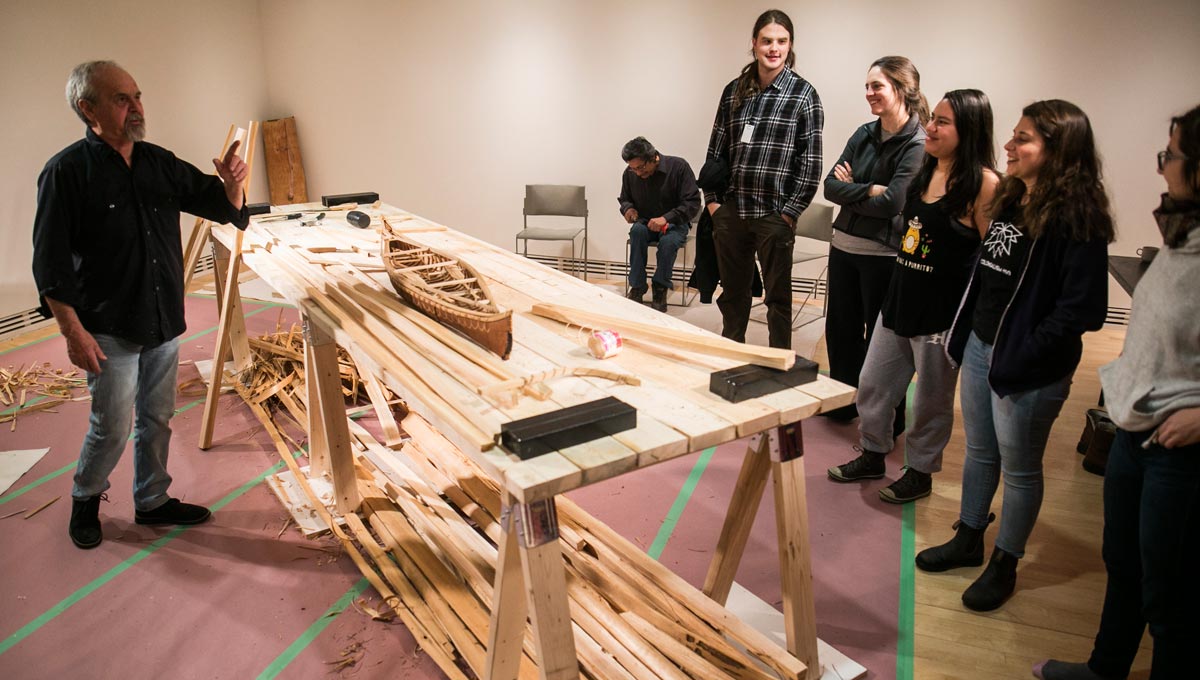
Pinock (left) and the builders share a laugh.
Although we will ensure that it touches water before next fall, the majority of our canoe’s life will be spent indoors, installed at the MacOdrum Library at Carleton University. Yet, as Nishnaabeg writer Leanne Simpson indicates, meaning arises out of context and process, not necessarily content. What gives our canoe weight is the collective creation of entwined relationships that formed and reformed throughout its very making. Pinock put this quite poignantly: “It’s not really the canoe that’s important. It’s learning how to build it, and learning how to communicate with each other.”
Pinock is a very treasured person in the Carleton University community. Known for his woodworking skills, and talents as an educator and workshop facilitator, he has always been immensely generous with his time. Also a bit of a trickster, his lighthearted teasing kept us laughing throughout our sessions, reminding us to be patient with our learning and to not to take ourselves too seriously—which in the academic space, can sometimes be difficult to achieve.
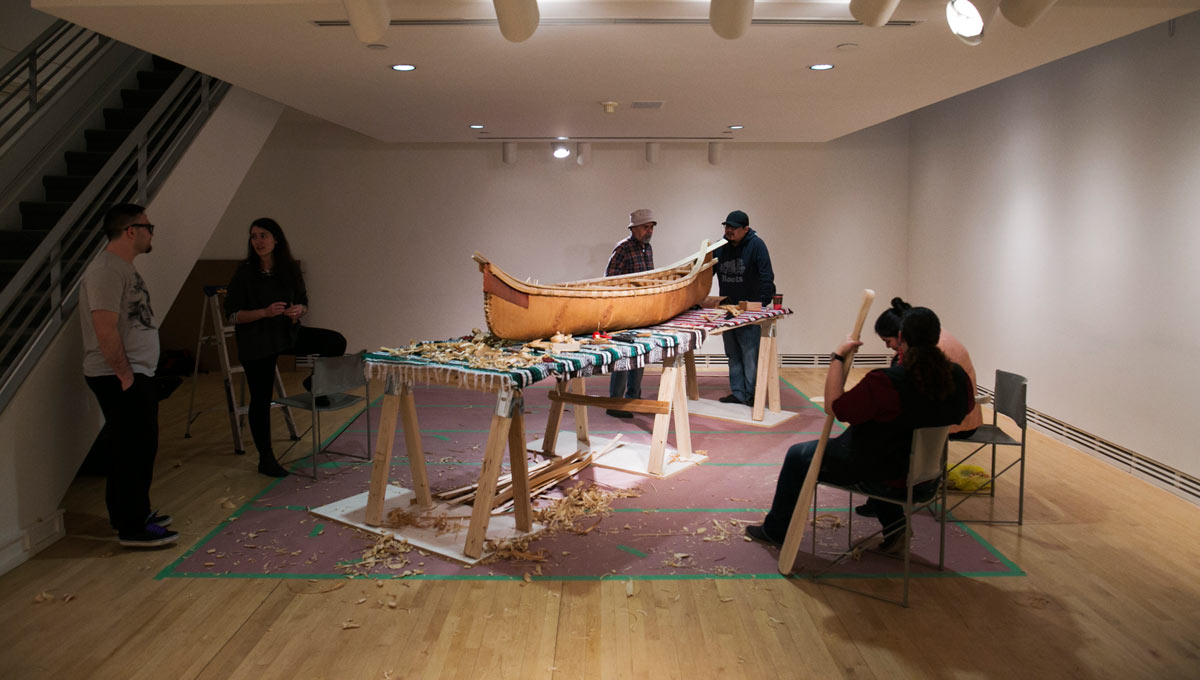
Huddled around the nearly finished <em>wiigwaas chiimaan</em>.
For many of us, it was the first time we had learned to work with these methods and materials. We often made mistakes and needed to ask for help.
“Don’t worry about it my girl,” Pinock would say after I’d get unbelievably frustrated when I couldn’t split thin strips of cedar wood without causing it to break, “you’ll learn to get a feel for it.”
This “learning to get a feel for it” arises from working the material with your own hands, listening for the right sound of the splitting wood, and carefully applying just the right amount of pressure down the rings of the cedar’s natural grain. Some people refer to these acute abilities as maker’s knowledge and Pinock has it in spades.
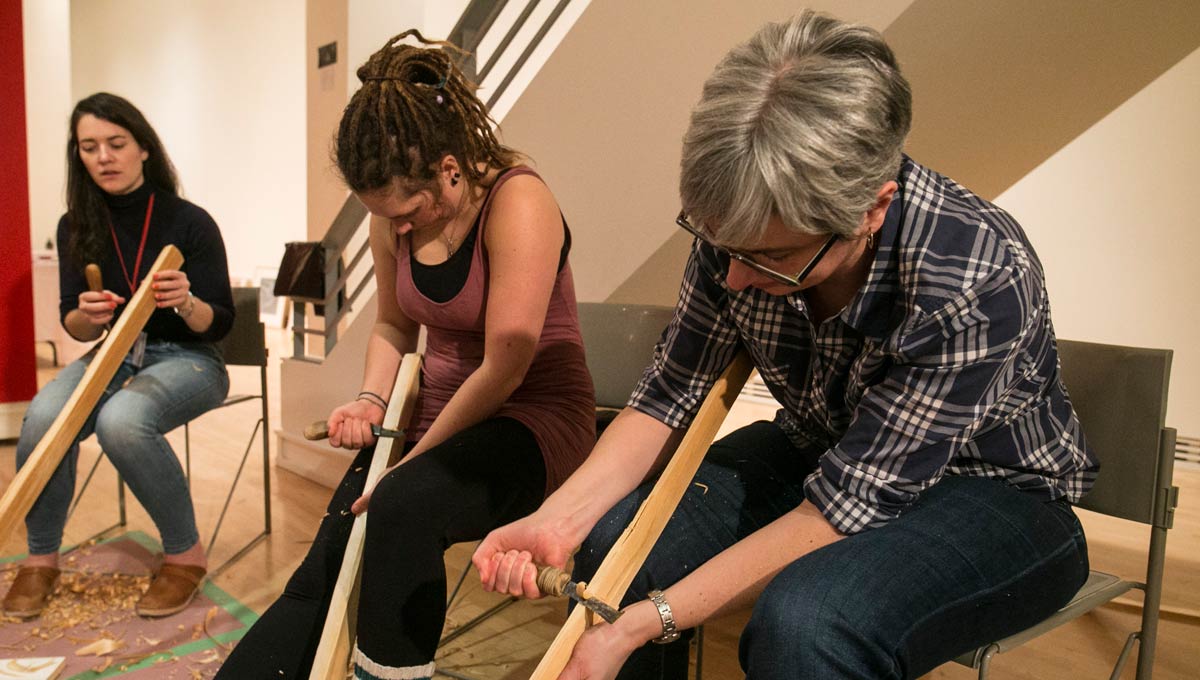
Experiential Learning is Critical
In many Indigenous ways of teaching, the value of experiential learning is critical. Learners carefully listen, observe and then set out to repeat those given teachings. In the hours we spent preparing our materials to craft our wiigwaas chiimaan, Pinock and his friend and assistant Paul “Mini” Stevens demonstrated the methods that we were to replicate.
The repetitive techniques of collectively cutting, cleaning, and lacing spruce root, and splitting and planing planks of cedar seemed to rhythmically stir and activate conversation, story, and memory. For some of the canoe builders, repeating these movements seemed to heighten our awareness that we were part of a continuum, that we were engaging in an Indigenous making-practice generations old, and there is an immeasurable amount of comfort in mimicking the motions of your ancestors’ hands.
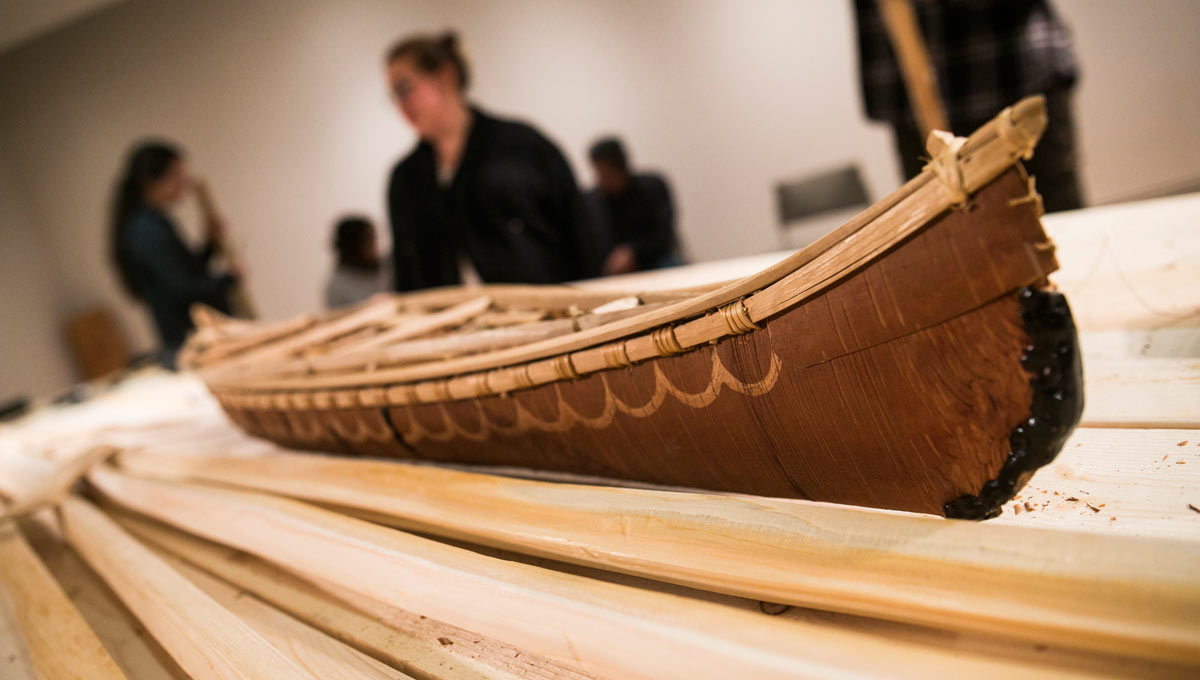
Kasia Czarski-Jachimowicz in concentration as she wraps roots around the gunnel of the canoe.
Summer-Harmony Twenish, an Art History student from Kitigan Zibi Anishinabeg, joined the workshop with a very special family member in mind. Having recently lost her grandmother—a lady known for her fine work in birchbark— she sought material and making as a way to reconnect with her and renew their relationship. These understandings of repetition, return and renewal are central to many theories about Indigenous knowledge which recognize, as Onkwehonwe scholar Deborah Doxtator has asserted, the past can exist in the present.
In many ways, our collective making formed new relationships while renewing old ones. Through our weekly canoe building gatherings, a group of people who began as relative strangers gradually grew to become good friends. In activating and restoring these kinds of meaningful connections, it seems fitting that our lessons should wrap up in April and May—ziigwaan— a time of cyclical return and regeneration, and that precious season when that beloved bark is cut, stretched and formed into vessels made to carry and hold sweetness and sustenance.
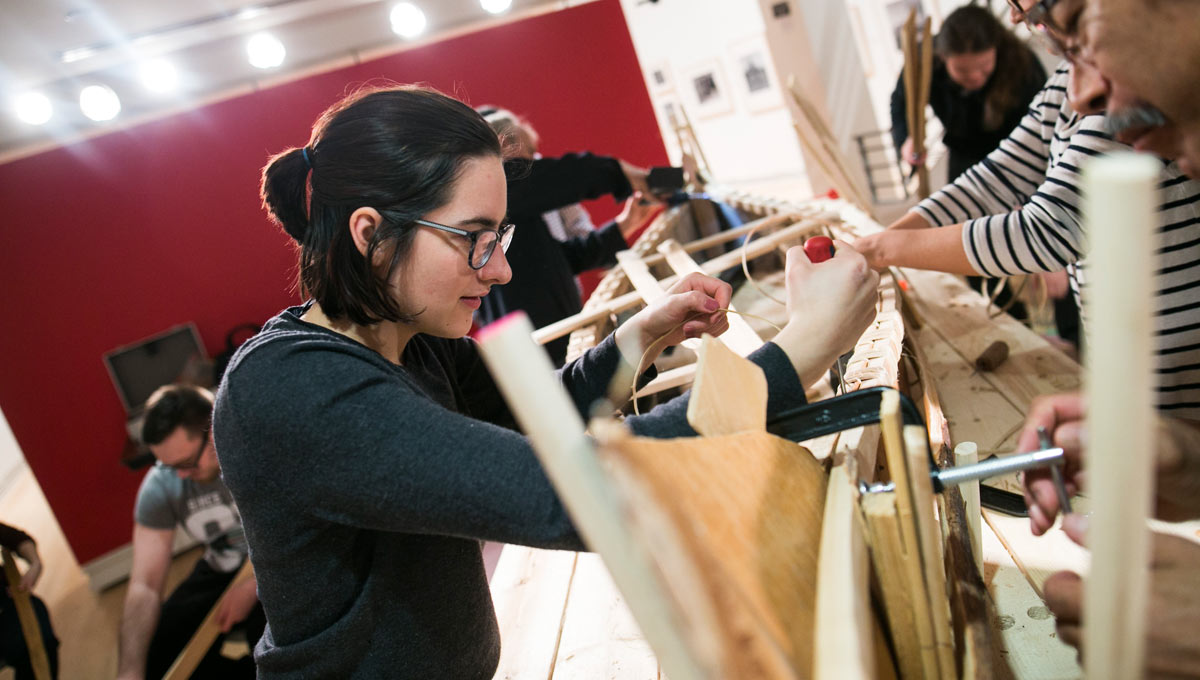
Kasia Czarski-Jachimowicz in concentration as she wraps roots around the gunnel of the canoe.
Gchi miigwech to our teachers, Pinock and Mini; the Centre for Aboriginal Culture and Education (CACE); the Carleton University Art Gallery (CUAG); and fellow canoe-builders and helpers: Jasmin Aguirre, Dwayne Cox, Kasia Czarskijachimowicz, Sandra Dyck, Ruston Fellows, Celeste Larocque, Michelle Matthisen, Benny Michaud, Annie Kingston Miller, Rodney Nelson, William Raffelsieper, Gabby Richichi-Fried, Naomi Sarazin, Leah Snyder, Summer-Harmony Twenish, and Fiona Wright.
Alexandra Kahsenni:io Nahwegahbow is Anishinaabe and Kanien’kehaÅL:ka and a member of Whitefish River First Nation. She is a PhD student in the Cultural Mediations program at Carleton University’s Institute for Comparative Studies in Literature, Art and Culture, where her research focuses on Indigenous visual and material culture from the Great Lakes region.
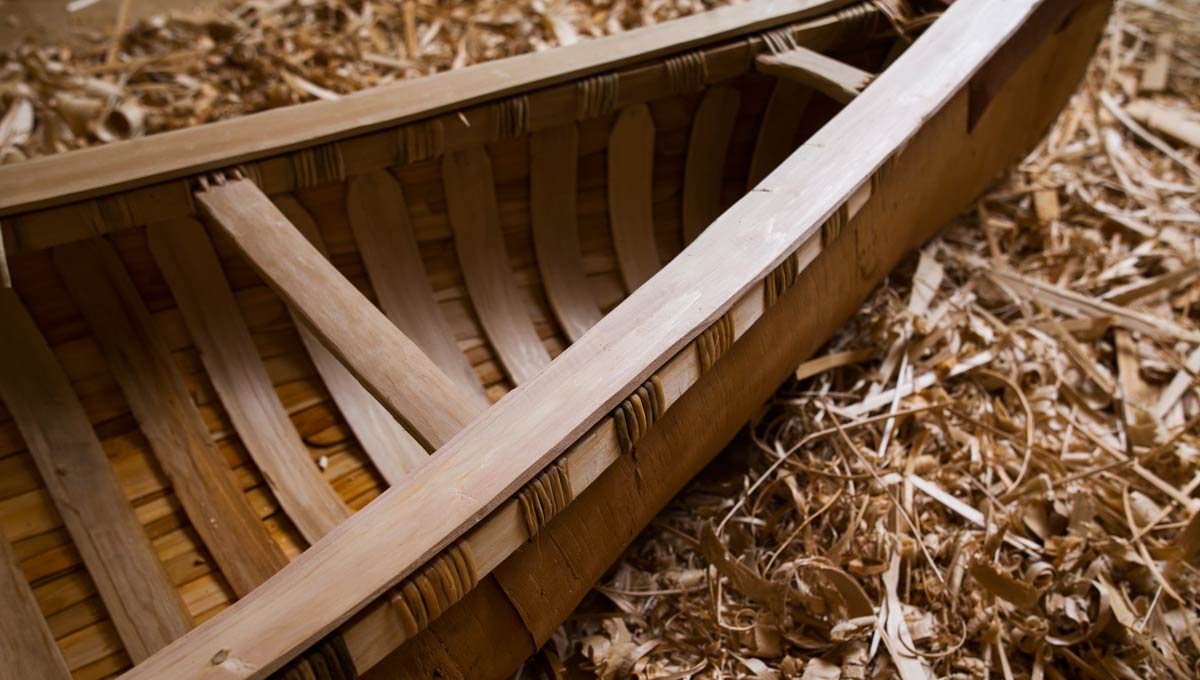
Tuesday, June 20, 2017 in Art Gallery, Community, Indigenous
Share: Twitter, Facebook
